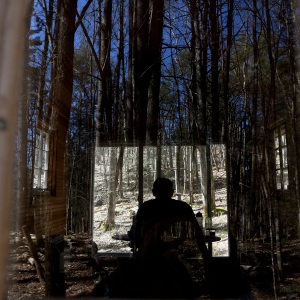Dartmouth archaeology team uncovers 8,000-year-old history at Weirs Beach
| Published: 05-30-2023 5:25 PM |
LACONIA, N.H. — An archaeology team from Dartmouth College found thousands of artifacts and artifact fragments recently at Weirs Beach, ranging from nails and glass of the 19th century to arrowheads dating back as far as 8,000 years.
In December, the same team underwent what was likely the area’s first archaeological radar survey to scan for potential sites. Now that snow has long departed and the ground thawed, the crew returned to conduct a small but fascinating dig into the past.
Post-doctoral fellow Nathaniel Kitchell said he was hoping to find items from as far back as 10,000 to 12,000 years but still called the dig a “learning experience.”
“In 1976, when the University of New Hampshire was out here previously, they located some areas that had human occupations going back at least 10,000 years, which is right after the end of the last Ice Age, which is a period of profound environmental and social change in this region,” Kitchell said. “The goal of this is to try to relocate some of those areas and gain a better understanding of what was going on and better contextualize the findings that had already been made in 1976 and to get a new radiocarbon date. We have better technology, so now we can do a little bit better.”
In many instances, archaeologists can approximate the age of an artifact based on the depth or layer of soil it was found in, but the Weirs threw a small wrench in this traditional method of dating.
Several decades ago, when the parking lot was rebuilt, soil was dredged from various locations around the region, including possibly Paugus Bay and Lake Winnipesaukee. This resulted in a dark-colored mixed layer, where time itself was warped.
“It’s that black layer that has all the artifacts in it,” Kitchell explained. “It has those very ancient arrowheads, but it also in some places has a lot of relatively recent historic artifacts: square-cut nails, bottle glass, window glass, some white glaze ceramics, things that are much more recent.”
Based upon this discovery, Kitchell explained that somewhere not far from the Weirs was a very important archaeological site.
Article continues after...
Yesterday's Most Read Articles
 Kenyon: Dartmouth shows it has no patience for peaceful protest
Kenyon: Dartmouth shows it has no patience for peaceful protest
 Claremont movie theater to close at end of May
Claremont movie theater to close at end of May
 Lebanon High senior comes to the aid of driver with health problem
Lebanon High senior comes to the aid of driver with health problem
 Editorial: Response to campus protests only adds fuel to the fire
Editorial: Response to campus protests only adds fuel to the fire
 Norwich author and educator sees schools as a reflection of communities
Norwich author and educator sees schools as a reflection of communities
 Dartmouth moves swiftly to stymie demonstration, leads to 90 arrests
Dartmouth moves swiftly to stymie demonstration, leads to 90 arrests
“There’s some indication that the lower levels of this black soil might be more intact than the upper levels. We’re still trying to figure this out,” Kitchell said. “That’s something we’ll be able to do more when we get back to the lab.”
Instead of using an artifact’s position in the soil to gain an approximate date, the researchers referenced a visual catalog.
The 8,000-year-old arrowhead mentioned before was part of the Neville variant, defined by sharp notches at the base.
“This is a very unique projectile point of the region,” explained doctoral student Jonathan Alperstein. “These have this kind of almost 90-degree and very narrow aspect to it.”
Moving 1,000 years forward, Alperstein displayed a “stark” point arrowhead that featured a less prominent point.
In addition to the college teams, volunteers from the State Conservation and Rescue Archaeology Program did most of the digging and sifting.
“For thousands of years there were people either camping or living right in this area,” volunteer George Leduc said. “I did some paid archeology work at the (Weirs) drive-in last winter in anticipation of them selling a piece of land.”
On Wednesday, the team had yet to reach the mythical 10,000-year-old layer, and time was running out.
“We’re gonna wrap this up Thursday, so we’ll be out of here Thursday afternoon,” Kitchell said.
“We have to be out of here before tourist season,” professor Jesse Casana said. “The most popular place for picnicking on the beach is right on this grass. Nathaniel has very carefully kept the grass intact so that when he puts it back on top, know one will even know we were here.”
These articles are being shared by partners in The Granite State News Collaborative. For more information visit collaborativenh.org.



 David Zuckerman is seeking reelection to lieutenant governor’s office
David Zuckerman is seeking reelection to lieutenant governor’s office Killington is the East’s largest ski resort. A developer wants to expand on that in a big way.
Killington is the East’s largest ski resort. A developer wants to expand on that in a big way.
